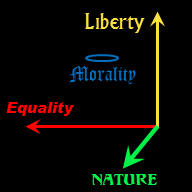The Balance of Wealth
“The rich get richer while the poor get poorer,” so the lament goes. Many solutions have been tried to fix this problem: high taxes, redistributions, usury laws, hyperinflation, price controls, labor camps and even mass exterminations. Usually these attempts fail. While one group of rich may be dealt with, another group arises. Power is a form of wealth[1]. Radical reform gives way to corruption, crony capitalism, or even cult of personality dictatorships that would make a god-emperor envious.
Some of the more moderate socialist movements have managed to close some of the income gaps, but even there many of the successes come at a price. Legacy corporations received freedom from competition since ambitious entrepreneurs are stifled by income-leveling measures. The result is something of a cuddly caste system.
Because of such a history, many freedom lovers and egalitarians have come to regard each other as enemies. This is ironic, since as I have stated elsewhere concentrations of wealth and concentrations of power have much in common. If wealth is to be distributed roughly equally, then responsibility needs to be distributed roughly equally, else the economy implodes. This same distributing of responsibility is also a prerequisite for a free society. Freedom lovers and egalitarians should be on the same side.
Instead, freedom-lovers often form alliances with modern-day aristocrats who spout free market rhetoric when it suits them, but whose primary objective is wealth preservation. The result is a tax system fraught with loopholes, government largesse showered on the rich and undeserving, and welfare programs for the middle and upper classes.
The deeper irony is that some of the most powerful egalitarian prescriptions can be found in the tomes of libertarian and even paleoconservative thought. However, these prescriptions are found in the middles of such books, bracketed with criticisms of the “welfare state” so that progressives rarely reach such chapters. Further, the egalitarian impacts of such prescriptions are usually noted as interesting side-effects of agendas whose prime purpose is to reduce the size of government and/or increase economic prosperity in general.
So what I will do in the next pages is dig up some of these ideas and show them for what they are: powerful steps for a more truly egalitarian society, steps that also lead to a more free society. But first, I will show why so many egalitarian activists have failed over the centuries. There is a subtle principle that must be understood, a principle that unlocks a plethora of ideas. The principle is actually quite simple, but not obvious. Simplicity is not simplistic.

